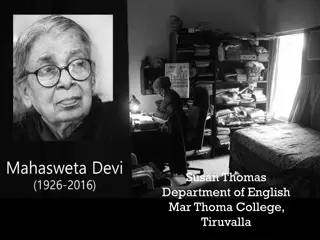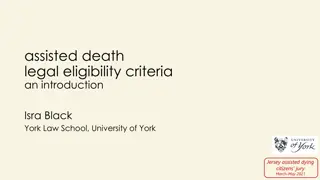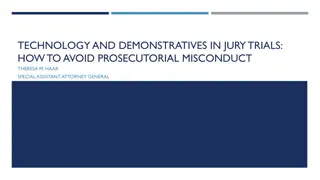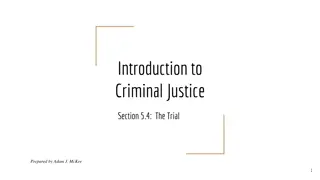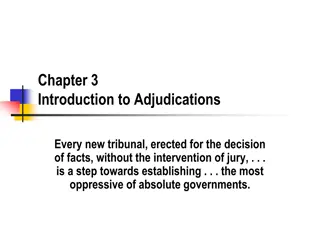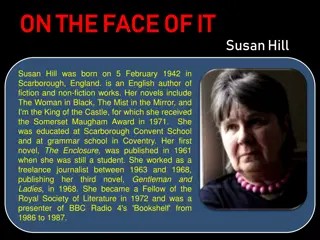The Intriguing Story of "A Jury of Her Peers" by Susan Glaspell
Explore the captivating background of Susan Glaspell, the societal context she was writing in, the characters in her story, and the plot analysis of "A Jury of Her Peers." Dive into a narrative that reflects on gender roles, justice, and the power of women's perspectives during a time of patriarchal dominance.
Uploaded on Sep 11, 2024 | 1 Views
Download Presentation

Please find below an Image/Link to download the presentation.
The content on the website is provided AS IS for your information and personal use only. It may not be sold, licensed, or shared on other websites without obtaining consent from the author. Download presentation by click this link. If you encounter any issues during the download, it is possible that the publisher has removed the file from their server.
E N D
Presentation Transcript
A Jury of Her Peers Susan Glaspell
Author Background Born on July 1, 1876, in Iowa where her dad sold animal feed and hay. Glaspell would often travel to farmsteads with her dad. Chose to become a reporter in the hopes of becoming a writer. Founded theatrical group called Provincetown Players with first husband. Most famous member was Eugene O Neill. In same year as divorce from second husband, Glaspell won Pulitzer Prize for Drama for Alison s House, a play based on Emily Dickinson s biography. Wrote other genres but most famous for plays. Glaspell died on July 27, 1948, at the age of 66.
Background of the Time Women were second-class citizens. They were considered a man s property that he could do with as he saw fit. Women didn t vote, have jobs, or hold civic positions. Patriarchal society where men dominate life at home and life at work. Women were viewed as simple minded and unable to have mature ideas/thoughts on their own.
Background of the Story Glaspell often wrote her stories with Iowa as the setting. This work was originally a one-act play, Trifles, that Glaspell adapted into the short-story version. Glaspell got the idea for the story and the dismal setting from an actual visit as a journalist to the house of Margaret Hossack, who was on trial for the murder of her husband. Play takes place in the kitchen instead of the murder scene or police station. The first third of the play is about the men but it then focuses more and more on what the women find, think, and decide.
Characters George Henderson county attorney investigating murder Henry Peters middle-aged local sheriff helping solve crime Lewis Hale neighboring farmer discovers murder when asking about a phone. He says, Women are use to worrying about trifles. Mrs. Peters newcomer who didn t know Minnie from before. Married to sheriff and follows the law. Understands loneliness. Thin and wiry with a nervous face. Mrs. Hale wife of Lewis Hale who resents condescension men show the females. Knew Minnie as young girl and feels guilty for not visiting. Larger woman. The Wrights
Plot Analysis Exposition: Setting Time Period and Place Other important background information we need to know about Mrs. Wright? Mrs. Hale? Mrs. Peters? Rising Action Mrs. Hale and Mrs. Peters accompany their husbands to the Wright s home why? What are the men looking for? Why don t they find anything? What are the women there to do? How do the women react to entering Mrs. Wright s home? Why do they react this way?
Plot Analysis More Rising Action What specific clues do the women find that begin to hint at the motive for the murder? What might be the symbolic nature of some of these clues? Climax The contents of the sewing kit How do we know this bird was special to Mrs. Wright? What does this bird symbolize? How would the revelation of the bird to the men change their perception of Mrs. Wright and her motives? Resolution Why do the women choose to not reveal the bird to their husbands? Why is the title of the story, A Jury of Her Peers?
Themes Female identity Law, duty, and justice Revenge Patriarchal dominance Domesticity Loneliness Empathy and protection
Pre-Writing The two central characters of A Jury of Her Peers are ones whom we never meet Mrs. and Mr. Wright. How does the author characterize Mr. Wright? What specifically do other characters say about him? What elements of the setting of the story contribute to your characterization of him? Contrast the descriptions of Minnie Foster with those of Minnie Wright List out all the ways that other characters describe her before and after her marriage, as well as after the murder. Based on the contrast between who she was before she married, and who she has been since she married, how would you characterize Mrs. Wright? What would her distinguishing character trait be?
Writing about the Wrights It s clear when this story begins that in all probability, Mrs. Wright killed her husband. As the story unfolds, we learn through the other characters what kind of people Mr. and Mrs. Wright were and why she may have killed him. Based on what you know from the story, do you feel Mrs. Wright was justified in killing her husband or not? Defend your position by explaining what kind of man and husband John Wright was, what kind of woman/wife Minnie Foster Wright was, and what the motive was for the killing. Be sure to use at least two direct quotations from the story to back up your argument.
















